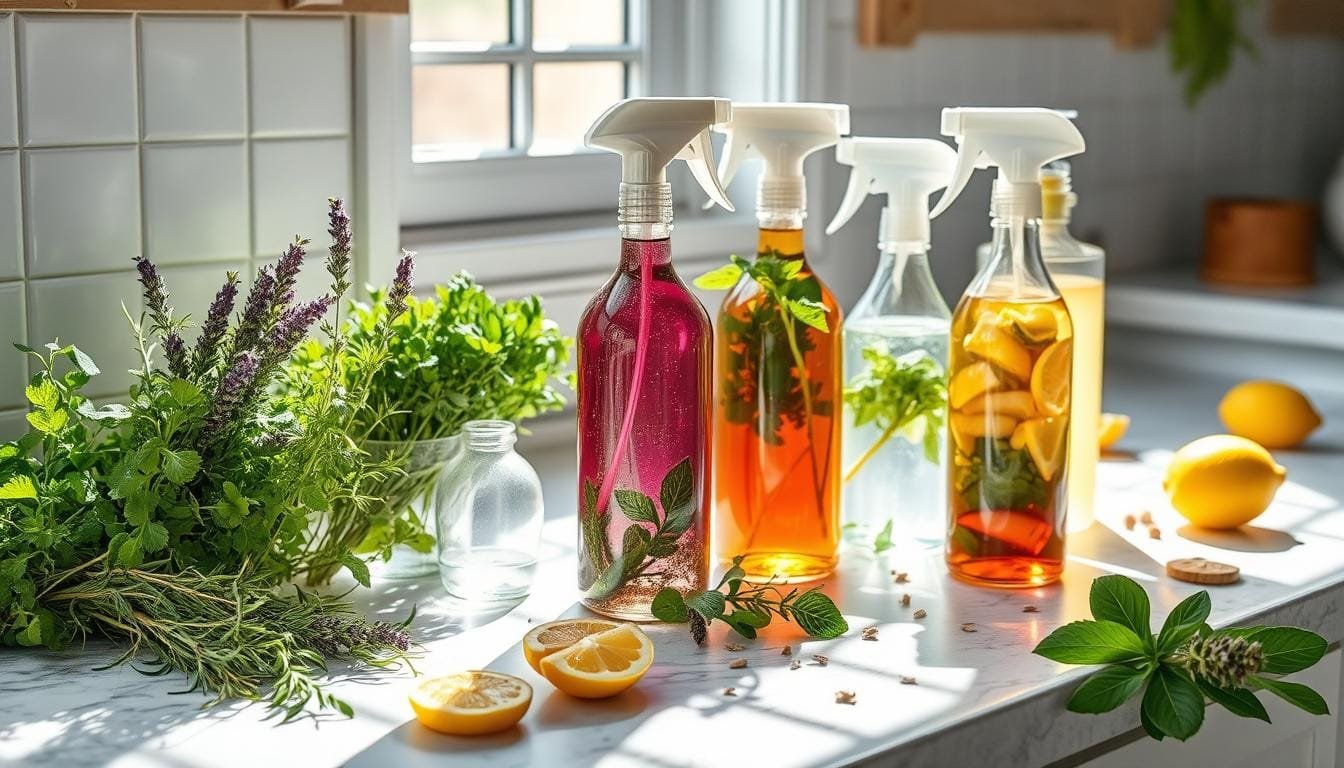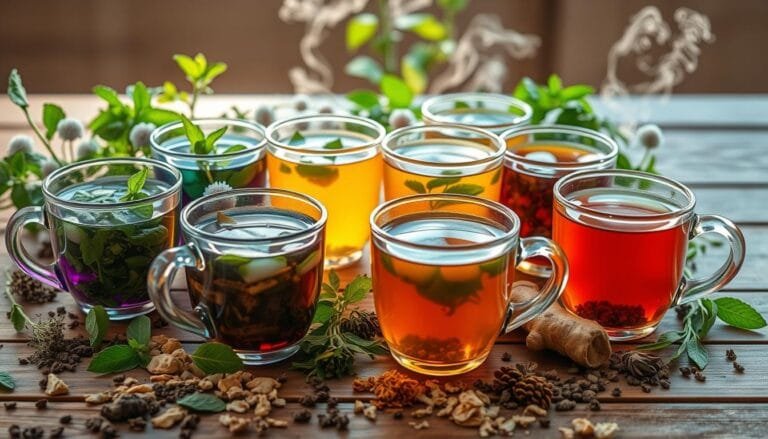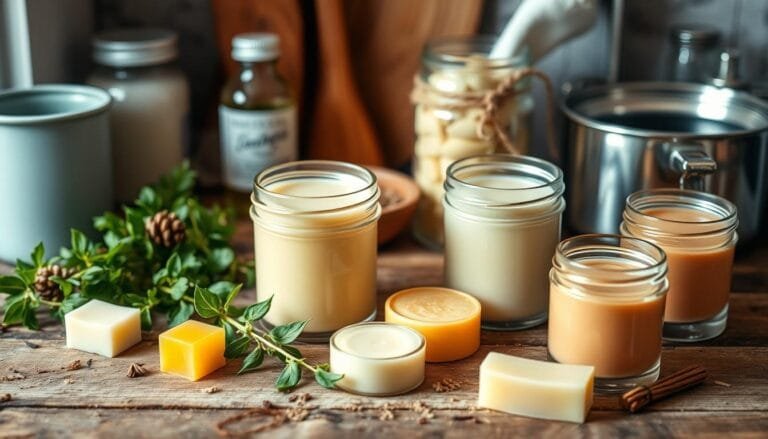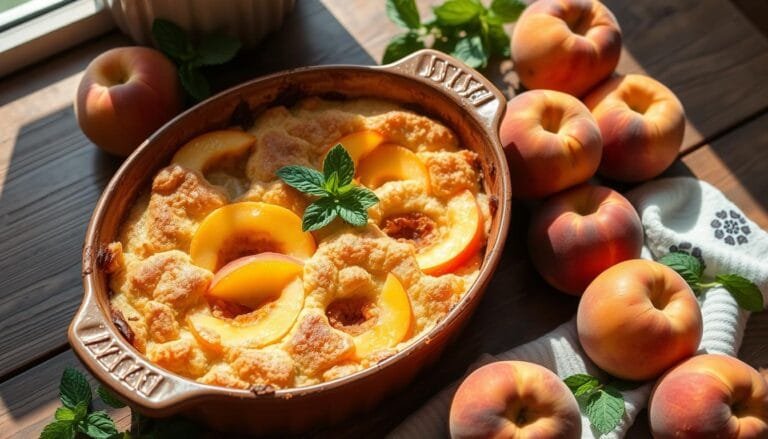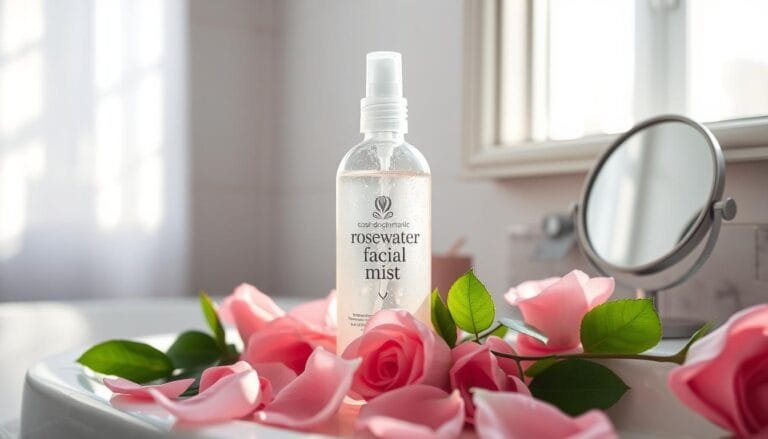Welcome to the world of natural homemade herbal sprays! It’s a great way to avoid synthetic fragrances. You can make your own scents using organic essential oils, hydrosols, and plant-based ingredients. Creating your own aromatherapy sprays can bring many benefits to your body, home, and linen.
In this guide, I’ll share how to pick the best ingredients and mix essential oils. You’ll learn how to make high-quality DIY herbal sprays. Whether you want to freshen up your room, create body mists, or make linen sprays, you’ll find the tips and inspiration here.
Join me as we explore natural, sustainable, and affordable alternatives to commercial products. You’ll learn how to use essential oil blends and herbal essences to improve your home and personal care. Let’s start making natural homemade herbal sprays for a healthier, more fragrant, and eco-friendly lifestyle.
Understanding the Benefits of Natural Herbal Sprays
Using natural herbal sprays is becoming more popular. They offer many benefits over commercial products. These sprays give us natural fragrance benefits and are good for our health and the planet.
Health Advantages Over Commercial Products
Commercial sprays often have harsh chemicals. Natural herbal sprays, on the other hand, use organic aromatherapy ingredients. They help our skin, mood, and brain without harming us.
Environmental Impact and Sustainability
Commercial sprays harm the environment. They use synthetic ingredients and plastic, causing pollution. Eco-friendly sprays are made from plants and come in recyclable containers. They are better for our planet.
Cost-Effective Alternative to Store-Bought Sprays
Homemade herbal sprays are cheaper than store-bought ones. You can make your own blends with natural ingredients. This way, you get natural fragrance benefits without spending a lot.
Choosing natural herbal sprays is good for your health and the environment. They use plants and essential oils to improve your day. This choice helps create a greener future.
Essential Supplies and Ingredients for Homemade Herbal Sprays
Making your own herbal sprays at home is very rewarding. You’ll need some basic supplies and ingredients to start. First, get glass spray bottles with mister tops. These are great for keeping your herbal sprays fresh.
Then, buy different essential oil kits. Try out various scents like floral, citrus, and woodsy. Choose organic ingredients to make sure your sprays are pure and work well.
- Glass spray bottles with mister tops
- Amber vials for testing blends
- Cobalt blue bottles for finished recipes
- Organic essential oil kits
- Organic hydrosols (floral waters)
- Witch hazel extract
- High-proof alcohol (such as vodka)
| Ingredient | Purpose | Recommended Ratio |
|---|---|---|
| Vodka | Base for homemade room spray | 1 ounce |
| Distilled water | Dilutes the spray | 3 ounces |
| Essential oils | Provide scent and therapeutic benefits | 15 drops |
With these DIY spray supplies, essential oil kits, and organic ingredients, you can make your own herbal sprays. Use them all over your home.
The Role of Base Ingredients in Natural Sprays
Base ingredients are key in making natural sprays work well. They mix everything together smoothly and keep the spray stable. Let’s look at three important ones: witch hazel, alcohol, and distilled water.
Understanding Witch Hazel and Its Properties
Witch hazel is a special extract used in natural sprays. It mixes essential oils with water-based parts. It also soothes and tones the skin, making it great for room, linen, and personal care sprays.
Choosing Between Alcohol Types
Alcohol is used to preserve and mix ingredients in sprays. You can choose from vodka, isopropyl alcohol, or grain alcohol. Vodka is clean and doesn’t change the scent of your spray. Isopropyl alcohol kills germs, and grain alcohol keeps sprays fresh longer. Pick the right alcohol for your needs.
The Importance of Distilled Water
Distilled water is best for making natural sprays. It’s pure and doesn’t have minerals or contaminants. This keeps your sprays fresh and effective for a longer time.
Knowing how to use witch hazel, alcohol, and distilled water makes your sprays better. They’ll last longer and look good. These ingredients are the foundation for amazing homemade herbal sprays.
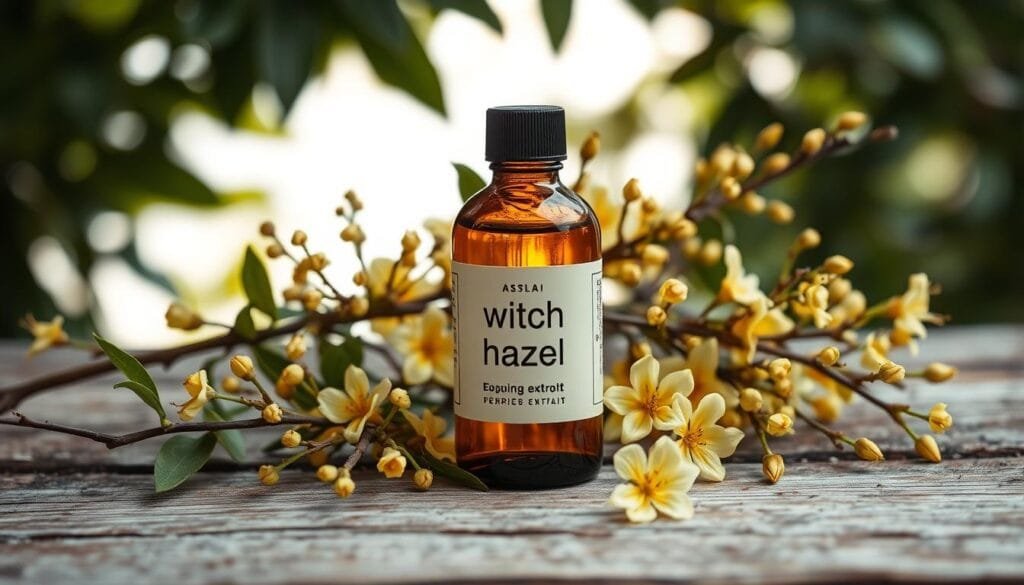
Essential Oils Selection Guide
When making your own organic essential oil sprays, choose high-quality, pure ingredients. Pick a mix of top, middle, and base notes for balanced aromatherapy blends. Favorites include floral scents like lavender, herbaceous notes from rosemary, and citrus oils.
Try different mixes to find your favorite organic essential oils blend. Each oil has its own benefits – some energize, while others calm or ground. By mixing various notes, you can make sprays that smell great and are good for you.
- Begin with 30% top notes like lemon, grapefruit, or peppermint for a strong start.
- Add 50% middle notes such as lavender, rosemary, or ylang-ylang for the scent’s core.
- End with 20% base notes like cedarwood, sandalwood, or frankincense to stabilize the blend.
“Blending essential oils is an art – experiment with different combinations to find what works best for you.”
For skin-safe sprays or body mists, use 1-2% essential oils. For perfumes and room fragrances, you can use up to 5%. Start small and adjust the ratios to get the scent and effects you want.
Basic Steps to Create Your First Herbal Spray
Making your own herbal cleaning spray is a fun and green project. It’s easy to make a spray that uses herbs’ natural power. Let’s get started and make your first homemade herbal spray!
Measuring and Mixing Techniques
First, get your ingredients ready: alcohol, witch hazel or hydrosol, and essential oils. For a 2-ounce spray, mix 1 ounce of alcohol, 24 drops of essential oils, and 1 ounce of witch hazel or hydrosol in a glass bottle. Shake it well to mix the essential oils right.
Proper Dilution Methods
- For an alcohol-free spray, mix 2% essential oils with witch hazel or hydrosol.
- Start with a small batch to test and adjust the recipe.
- Essential oils should be no more than 5% of the total volume to avoid skin problems.
Storage and Shelf Life Tips
Keep your DIY spray recipe in a dark glass bottle, away from sunlight and heat. Shake it before each use to mix the ingredients well. With good herbal spray storage, it can last up to 6 months.
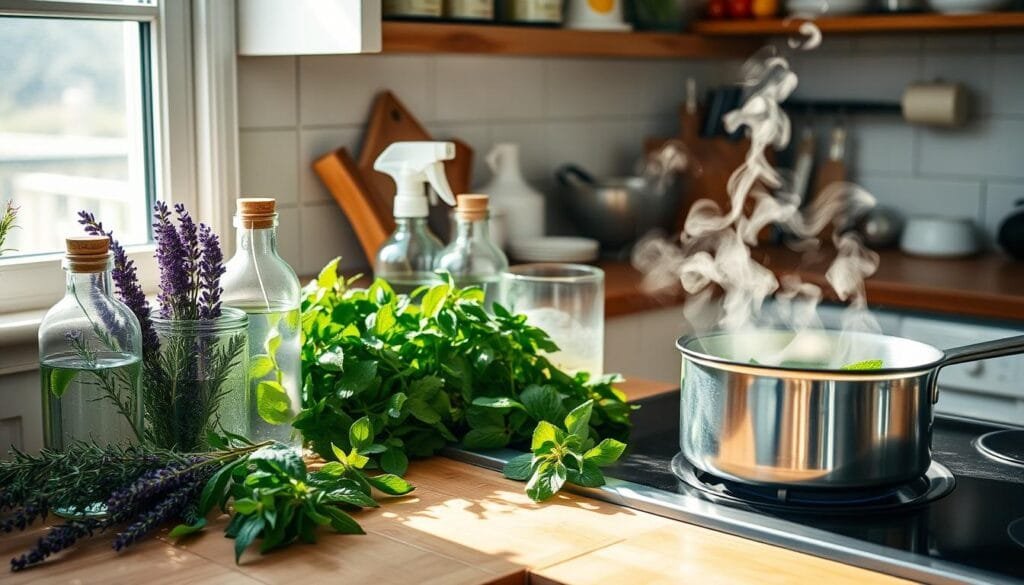
Making natural cleaning sprays at home is rewarding and good for the planet. By following these steps, you can make your own herbal sprays. Start trying different herbs and essential oils to find your favorite scent!
Popular Essential Oil Combinations and Their Uses
Making your own essential oil blends is a fun way to make aromatherapy personal. You can choose from many blends to energize, relax, or just enjoy a nice smell. Let’s look at some popular blends and what they’re for.
For a morning pick-me-up, try mixing sweet orange, cardamom, and ginger. This mix is citrusy and spicy, great for waking up your senses and sharpening your mind. For a calming evening, try neroli and sandalwood. It’s perfect for unwinding after a busy day.
Looking for something calming yet refreshing? Mix ylang-ylang and spearmint. For a bright and cheerful scent, try lime and grapefruit. It’s great for making your space feel happy and welcoming.
Want a scent that feels earthy and grounding? Try cedarwood, geranium, and ginger. You can adjust the amounts to create a scent that’s just right for you.
| Blend | Purpose | Key Essential Oils |
|---|---|---|
| Energizing | Invigorating and Mentally Stimulating | Sweet Orange, Cardamom, Ginger |
| Relaxing | Calming and Soothing | Neroli, Sandalwood |
| Balancing | Promoting Harmony and Equilibrium | Ylang-Ylang, Spearmint |
| Refreshing | Uplifting and Cheerful | Lime, Grapefruit |
| Grounding | Earthy and Soothing | Cedarwood, Geranium, Ginger |
Creating essential oil blends is a journey of discovery. Try different mixes to find scents that are uniquely yours. This way, you can enjoy the benefits of aromatherapy every day.
Natural Room and Linen Spray Recipes
Making your own room spray and linen freshener is a great way to enjoy essential oils. You can avoid harsh chemicals found in many air fresheners. You can also pick scents you like, making your space feel fresh and new.
Fresh Floral Blend Recipe
Make a floral mist that refreshes with this easy recipe:
- 10 drops geranium essential oil
- 20 drops lavender essential oil
- 5 drops rosemary essential oil
Put these oils in 1.5 oz of distilled water and 1.5 oz of witch hazel in a 4 oz bottle. Shake it well before each use. Enjoy the natural scent in your home.
Citrus Energizing Spray
Boost your mood and energize your space with this citrus mix:
- 20 drops lemongrass essential oil
- 20 drops sweet orange essential oil
Blend the oils with 1.5 oz each of distilled water and witch hazel in a 4 oz bottle. The scent will make you feel refreshed.
Calming Lavender Mixture
Find peace and calm with this lavender recipe:
- 20 drops lavender essential oil
- 20 drops rose essential oil
Put the oils in your 4 oz bottle with water and witch hazel. Use it in your bedroom or living room for a calm moment.
Feel free to change the amount of essential oils to match your taste. These DIY room spray, natural linen freshener, and homemade air freshener recipes are simple and better for you than store-bought ones.
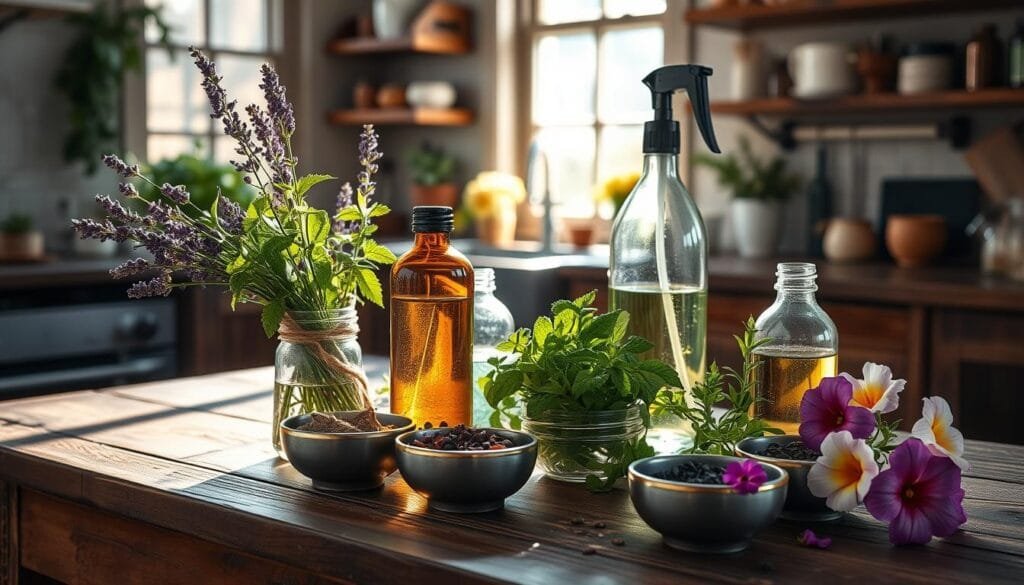
Safety Guidelines and Best Practices
When using essential oils for homemade sprays, safety is key. Always dilute oils correctly and test them on your skin first. Make sure to avoid spraying your eyes and sensitive areas to prevent irritation.
It’s also important to store your oils and sprays safely. Keep them out of children and pet reach. Be careful with oils like citrus, as they can make your skin more sensitive to the sun. Always check the safety of each oil, even more so if you’re pregnant or have health issues.
- Dilute essential oils properly – use only 1-5% concentration in your sprays
- Perform patch tests before using new blends on your skin
- Keep sprays away from eyes and mucous membranes
- Store ingredients and sprays safely, out of reach of kids and pets
- Research photosensitive oils and avoid using them before sun exposure
- Check for any contraindications, specially if you’re pregnant or have health conditions
By following these essential oil safety and natural spray precautions, your DIY aromatherapy tips will be safe and effective. With a bit of care, you can make great herbal sprays at home.
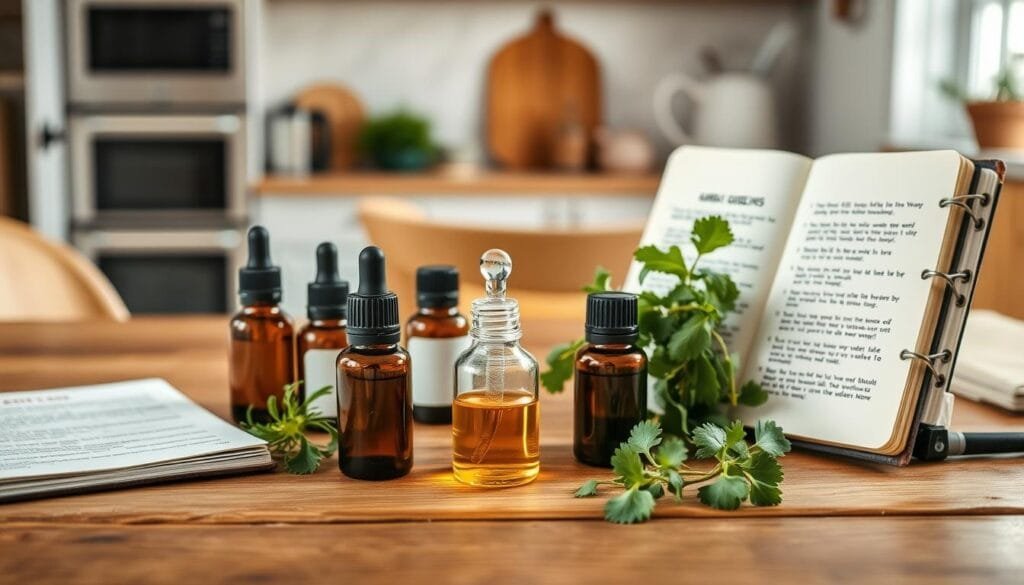
“Proper use of essential oils can help alleviate certain health issues with minimal side effects, such as reducing nausea with ginger vapors or fighting bacterial infections with tea tree oil.”
Storing Essential Oils Properly
Essential oils should not be kept for more than 3 years. Older oils can spoil due to oxygen exposure. Always mix essential oils with vegetable oils or creams, keeping the essential oil concentration between 1% to 5%.
Children and the elderly may be more sensitive to essential oils. They might need even more dilution and should avoid certain oils like birch and wintergreen. Essential oils can cause skin reactions like rashes or itching. If you notice any irritation, wash the affected area with water.
Customizing Your Homemade Herbal Sprays
Making your own herbal sprays lets you tailor them to your liking. You can mix different essential oils to create unique scents. These can match your mood, the season, or the vibe you want.
Think about your favorite smells and how you’ll use the spray. Maybe you love the calmness of lavender for a bedroom mist. Or, you might prefer the zing of grapefruit and lemon for a boost at work. Check out the essential oil guide in Section 5 to learn more about each oil’s benefits.
Feel free to experiment with your blends. Try mixing rosemary with vanilla or cedarwood with frankincense. You can also add dried herbs or flowers for extra beauty and scent. Keep track of your favorite recipes and tweak them to get the perfect smell.
